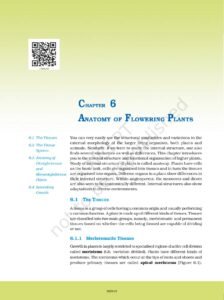Understanding the Anatomy of Flowering Plants: A Comprehensive Guide
Flowering plants, also known as angiosperms, exhibit a remarkable diversity in size, shape, and structure. The study of their anatomy provides crucial insights into their growth, development, and ecological significance. In this article, we delve into the intricacies of plant anatomy, as outlined in the NCERT PDF on Anatomy of Flowering Plants.
**Roots:**
The root system of flowering plants plays a fundamental role in anchoring the plant to the soil and absorbing water and nutrients. It consists of the primary root and its branches, known as lateral roots. Within the root, various layers such as the epidermis, cortex, endodermis, and vascular tissues facilitate these functions.
**Stems:**
Stems provide structural support to the plant and serve as conduits for the transport of water, minerals, and sugars. They exhibit a diverse range of modifications, including herbaceous and woody stems, as well as specialized structures like rhizomes, stolons, and tubers.
**Leaves:**
Leaves are the primary sites of photosynthesis, where plants harness sunlight to produce energy. Their anatomy comprises several layers, including the epidermis, mesophyll, and vascular bundles. Different types of leaves, such as simple, compound, and modified leaves, serve various functions like storage, protection, and reproduction.
**Flowers:**
Flowers are the reproductive structures of flowering plants, responsible for producing seeds. Their anatomy includes four main parts: sepals, petals, stamens, and carpels. Each part plays a vital role in the process of pollination and fertilization, leading to the formation of fruits and seeds.
**Fruits and Seeds:**
Fruits develop from fertilized ovaries and protect the developing seeds. They exhibit diverse forms and functions, including dispersal mechanisms and nutritional benefits for animals. Seeds contain the embryo of the plant, along with stored food reserves, enclosed within protective seed coats.
**Providing Access to NCERT PDF:**
For those seeking a comprehensive understanding of the anatomy of flowering plants, access to the NCERT PDF on the subject is indispensable. To facilitate this, our website offers a downloadable version of the Anatomy of Flowering Plants NCERT PDF. With easy access to this resource, students, educators, and enthusiasts can deepen their knowledge and appreciation of plant anatomy.
In conclusion, the study of the anatomy of flowering plants is essential for understanding their structure, function, and ecological significance. By exploring the intricate details outlined in the NCERT PDF, enthusiasts can gain a deeper appreciation for the marvels of plant life and its contributions to our ecosystem.
